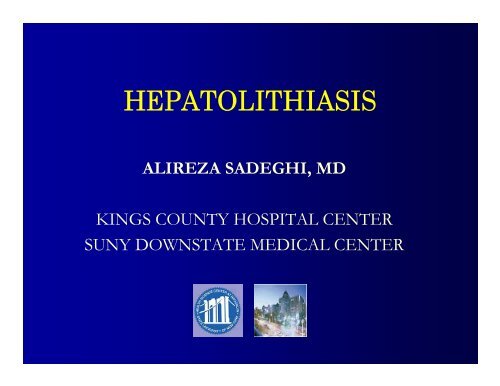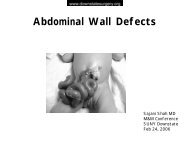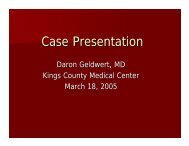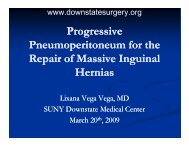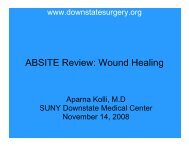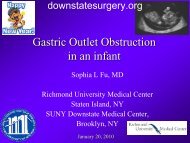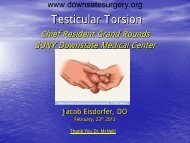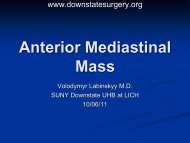hepatolithiasis - Department of Surgery at SUNY Downstate Medical ...
hepatolithiasis - Department of Surgery at SUNY Downstate Medical ...
hepatolithiasis - Department of Surgery at SUNY Downstate Medical ...
You also want an ePaper? Increase the reach of your titles
YUMPU automatically turns print PDFs into web optimized ePapers that Google loves.
HEPATOLITHIASIS<br />
ALIREZA SADEGHI, MD<br />
KINGS COUNTY HOSPITAL CENTER<br />
<strong>SUNY</strong> DOWNSTATE MEDICAL CENTER
Surgical Management <strong>of</strong><br />
HEPATOLITHIASIS<br />
ALIREZA SADEGHI, MD<br />
<strong>SUNY</strong> DOWNSTATE MEDICAL CENTER
Overview<br />
• HEPATOLITHIASIS:<br />
– Historical Perspectives<br />
– Definition<br />
– Epidemiology & N<strong>at</strong>ural<br />
History<br />
– Etiology <strong>of</strong> Biliary Stones<br />
– Classific<strong>at</strong>ion Systems<br />
– Symptoms<br />
– Diagnosis<br />
– Tre<strong>at</strong>ment Regiments<br />
– Conclusion
Historical Perspectives<br />
• Vachell & Stevens (1906)<br />
– First published report <strong>of</strong> Intrahep<strong>at</strong>ic Calculi<br />
• By 1930, multiple descriptions<br />
– Recurrent Pyogenic Cholangitis<br />
– Hong Kong Disease<br />
– Biliary Obstruction Syndrome <strong>of</strong> the Chinese<br />
– Oriental Cholangitis<br />
– Oriental Infest<strong>at</strong>ional Cholangitis<br />
– Intrahep<strong>at</strong>ic Lithiasis<br />
Vachell HR, Stevens WM: Case <strong>of</strong> Intrahep<strong>at</strong>ic Calculi. Br Med J1906;1:434-36
Definition<br />
• Calculi or concretions<br />
– loc<strong>at</strong>ed proximal to the confluence <strong>of</strong> the<br />
right and left hep<strong>at</strong>ic ducts<br />
• Stones are present in Right and/or Left<br />
hep<strong>at</strong>ic ducts and/or their tributaries<br />
irrespective <strong>of</strong> the coexistence <strong>of</strong><br />
choledocholithiasis or cholecystolithiasis<br />
Nakayama F. Intrahep<strong>at</strong>ic Stones; Blumgart’s <strong>Surgery</strong> <strong>of</strong> the Liver & Biliary Tract. 765-774. 1994
Epidemiology<br />
• Occurs mainly in Southeast Asia:<br />
– China, Korea, Japan, Taiwan, Philippines, Vietnam,<br />
Thailand, Malaysia, Brazil, Indonesia and India<br />
– Incidence reported to be 20-30% <strong>of</strong> all p<strong>at</strong>ients<br />
undergoing surgery for gallstone disease.<br />
– Low incidence in Europe and North America<br />
– With increased immigr<strong>at</strong>ion more cases are being<br />
reported in the North American institutions however<br />
there is little experience in tre<strong>at</strong>ing the condition<br />
Nakayama F. Intrahep<strong>at</strong>ic Stones; Blumgart’s <strong>Surgery</strong> <strong>of</strong> the Liver & Biliary Tract. 765-774. 1994
Epidemiology<br />
•St<strong>at</strong>istics<br />
Nakayama F. Intrahep<strong>at</strong>ic Stones; Blumgart’s <strong>Surgery</strong> <strong>of</strong> the Liver & Biliary Tract. 765-774. 1994
Epidemiology<br />
• Incidence<br />
– Equal gender distribution<br />
– Affects p<strong>at</strong>ients in 3rd to 7th decades on life<br />
– More common in rural areas <strong>of</strong> Southeast<br />
Asia among the lower socio-economic class<br />
– Overall incidence in East Asia is declining<br />
• China & Taiwan: 20%<br />
• Japan: 2.2%<br />
Nakayama F. Intrahep<strong>at</strong>ic Stones; Blumgart’s <strong>Surgery</strong> <strong>of</strong> the Liver & Biliary Tract. 765-774. 1994
Epidemiology<br />
• Incidence in Europe & North America<br />
• Very low prevalence
Classific<strong>at</strong>ion<br />
• Most recent system: Nakayama in 1982<br />
• Presence <strong>of</strong> stones in the intra-hep<strong>at</strong>ic bile ducts: I<br />
• Presence <strong>of</strong> stones in the intra & extra-hep<strong>at</strong>ic bile<br />
ducts: IE<br />
• Right & Left hep<strong>at</strong>ic ducts distal to the confluence<br />
• Segmental ducts are divided into central &<br />
peripheral<br />
– Central: Ducts <strong>of</strong> first and second branches<br />
Nakayama F. Hep<strong>at</strong>olithiasis in East Asia. Digestive Diseases & Sciences. 1986; 30(1):21-26
Classific<strong>at</strong>ion<br />
Nakayama F. Hep<strong>at</strong>olithiasis in East Asia. Digestive Diseases & Sciences. 1986; 30(1):21-26
Classific<strong>at</strong>ion<br />
• Nakayama: 1982<br />
– Strictures (S): decrease in the diameter <strong>of</strong> bile<br />
ducts rel<strong>at</strong>ive to adjacent parts.<br />
• S0: Absence <strong>of</strong> stricture<br />
• S1: Slight stricture (Diameter > 2mm)<br />
• S2: Marked stricture (Diameter < 2 mm)<br />
Nakayama F. Hep<strong>at</strong>olithiasis in East Asia. Digestive Diseases & Sciences. 1986; 30(1):21-26
Classific<strong>at</strong>ion<br />
• Nakayama: 1982<br />
– Dil<strong>at</strong><strong>at</strong>ion (D): increase in diameter <strong>of</strong> bile<br />
duct beyond physiological range<br />
– D0: Absence <strong>of</strong> dil<strong>at</strong><strong>at</strong>ion<br />
– D1: Slight dil<strong>at</strong><strong>at</strong>ion<br />
– D2: Marked dil<strong>at</strong><strong>at</strong>ion<br />
– Extrahep<strong>at</strong>ic Bile Ducts:<br />
» 20 mm divides D1 and D2<br />
– Intrahep<strong>at</strong>ic Bile Ducts:<br />
» 10 mm divides D1 and D2<br />
Nakayama F. Hep<strong>at</strong>olithiasis in East Asia. Digestive Diseases & Sciences. 1986; 30(1):21-26
Classific<strong>at</strong>ion<br />
• Additional Criteria<br />
• Gallbladder (G)<br />
– Cholesterol stones: “Gc”<br />
– Calcium Bilirubin<strong>at</strong>e: “Gb”<br />
– Uncertain type <strong>of</strong> stone: “Gx”<br />
• Extrahep<strong>at</strong>ic Bile Ducts (B)<br />
• Intrahep<strong>at</strong>ic Bile Ducts (H)<br />
Nakayama F. Hep<strong>at</strong>olithiasis in East Asia. Digestive Diseases & Sciences. 1986; 30(1):21-26
Classific<strong>at</strong>ion<br />
Nakayama F. Hep<strong>at</strong>olithiasis in East Asia. Digestive Diseases & Sciences. 1986; 30(1):21-26
Etiology<br />
• Intrahep<strong>at</strong>ic Lithiasis<br />
– East vs. West<br />
– In the west is generally thought to be secondary to<br />
stones origin<strong>at</strong>ing in the gall bladder or primarily<br />
resulting from benign strictures, sclerosing cholangitis,<br />
choledochal cysts or malignant biliary tumors.<br />
– In the East it is regarded as a separ<strong>at</strong>e entity altogether.<br />
The majority <strong>of</strong> cases are associ<strong>at</strong>ed with recurrent<br />
pyogenic cholangitis in regions with parasitic<br />
infest<strong>at</strong>ions<br />
Rao et al. Intrahep<strong>at</strong>ic Stones – an etiological quagmire. Indian J Gastroenterology 2004;23:201-2
Etiology<br />
• Ethnic vs. Environmental factors<br />
• Survey by Nakayama looked <strong>at</strong> the proportion <strong>of</strong><br />
HL in different provinces <strong>of</strong> China as compared<br />
to th<strong>at</strong> <strong>of</strong> HL in Japan:<br />
– Taiwan 53.1%<br />
– Hong Kong 3.1%<br />
– Singapore 1.7%<br />
– Japan 4.1%<br />
• In spite <strong>of</strong> a similar ethnic background (Chinese<br />
descent) the rel<strong>at</strong>ive proportion <strong>of</strong> HL is marked<br />
different in Taiwan, Hong Kong & Singapore<br />
Nakayama F. Hep<strong>at</strong>olithiasis in East Asia. Digestive Diseases & Sciences. 1986; 30(1):21-26
Etiology<br />
• Environmental factors<br />
– Parasitic Infest<strong>at</strong>ions<br />
• Clonorchis Sinensis & Ascaris Lumbricoides<br />
– Despite <strong>of</strong> epidemiologic associ<strong>at</strong>ion, evidence<br />
supporting the role <strong>of</strong> these infections in p<strong>at</strong>hogenesis<br />
is inconclusive.<br />
– Infest<strong>at</strong>ions can only be demonstr<strong>at</strong>ed in 30% <strong>of</strong><br />
p<strong>at</strong>ients with HL.<br />
– HL is common in some Asian countries in which<br />
Parasites are not endemic<br />
» Certain areas <strong>of</strong> Malaysia, China & Taiwan with<br />
high prevalence <strong>of</strong> HL are virtually free <strong>of</strong><br />
Clonorchis<br />
Yellin AE et al Biliary lithiasis and helminthiasis. Am J Surg 1981;142:128.
Etiology<br />
• Parasites<br />
• Theory:<br />
– Analysis <strong>of</strong> stones have shown debris & ova<br />
which may have served as a nidus for stone<br />
form<strong>at</strong>ion<br />
– This is probably incidental r<strong>at</strong>her than<br />
caus<strong>at</strong>ive and may merely be an associ<strong>at</strong>ion<br />
with stones in endemic areas <strong>of</strong> infest<strong>at</strong>ion<br />
Yellin AE et al Biliary lithiasis and helminthiasis. Am J Surg 1981;142:128.
Etiology<br />
• Environmental factors<br />
– Bacterial Infections<br />
• Human bile is Sterile under normal circumstances<br />
• Incidence <strong>of</strong> Bacteria in bile <strong>of</strong> p<strong>at</strong>ients with HL is almost<br />
100% in most series<br />
• Bacteria commonly found:<br />
– Klebsiella sp<br />
– E. Coli<br />
– Pseudomonas sp<br />
– Entercoccous sp<br />
– Bacteroides sp<br />
• Entry route: access biliary tree by injury from a parasitic<br />
infection<br />
Sheen-Chen SM et al. Bacteriology & Antimicrobial choices in Hep<strong>at</strong>olithiasis. AJIC 2000;28:298-301
Etiology<br />
• Bacterial Infection<br />
• Polymicrobial infection usually prevails<br />
• Most bacterial species present show Bglucoronidase<br />
activity<br />
Nakayama F. Intrahep<strong>at</strong>ic Stones; Blumgart’s <strong>Surgery</strong> <strong>of</strong> the Liver & Biliary Tract. 765-774. 1994
Etiology<br />
• Bacterial infection<br />
• B-Glucuronidase is responsible for c<strong>at</strong>alyzing the<br />
hydrolysis <strong>of</strong> direct bilirubin to the indirect<br />
unconjug<strong>at</strong>ed form<br />
• Unconjug<strong>at</strong>ed bilirubin is w<strong>at</strong>er-insoluble &<br />
combines with calcium bilirubin<strong>at</strong>e to form<br />
Calcium Bilirubin<strong>at</strong>e (PIGMENT) stones which<br />
comprise the majority <strong>of</strong> the cases <strong>of</strong><br />
Hep<strong>at</strong>olithiasis (80%)<br />
• Cholesterol & mixed stones are increasing (10%)<br />
as the western diet invades Asia<br />
Nakayama F. Intrahep<strong>at</strong>ic Stones; Blumgart’s <strong>Surgery</strong> <strong>of</strong> the Liver & Biliary Tract. 765-774. 1994
Etiology<br />
Nakayama F. Intrahep<strong>at</strong>ic Stones; Blumgart’s <strong>Surgery</strong> <strong>of</strong> the Liver & Biliary Tract. 765-774. 1994
Etiology<br />
• Bile Stasis<br />
• Main cause <strong>of</strong> Intrahep<strong>at</strong>ic Stones in the West<br />
• Stenosis & Strictures<br />
– Benign strictures<br />
» Postoper<strong>at</strong>ive: Most Common Etiology<br />
– Sclerosing Cholangitis<br />
– Choledochal cysts<br />
– Malignant biliary tumors<br />
Rao et al. Intrahep<strong>at</strong>ic Stones – an etiological quagmire. Indian J Gastroenterology 2004;23:201-2
Etiology<br />
• Other factors<br />
– Diet<br />
• Asian diet:<br />
– high in carbohydr<strong>at</strong>es and low in f<strong>at</strong> & protein.<br />
• S<strong>at</strong>ur<strong>at</strong>ed f<strong>at</strong>s causes CCK release & relax<strong>at</strong>ion <strong>of</strong><br />
the sphincter <strong>of</strong> Oddi<br />
– Low f<strong>at</strong> diet leads to biliary stasis<br />
• Low protein diet<br />
– Low level <strong>of</strong> Glucaro-1.4-lactone which is an inhibitor<br />
<strong>of</strong> B-Glucuronidase, potenti<strong>at</strong>ing the deconjung<strong>at</strong>ion<br />
reaction<br />
Rao et al. Intrahep<strong>at</strong>ic Stones – an etiological quagmire. Indian J Gastroenterology 2004;23:201-2
Etiology<br />
• Rare causes:<br />
– I<strong>at</strong>rogenic Factors
Loc<strong>at</strong>ion<br />
• Left duct involvement > Right ducts<br />
– Reason for preponderance is unknown<br />
– Left duct courses horizontally in rel<strong>at</strong>ion to<br />
the CHD as compared to the right duct<br />
forming an acute angle<br />
– Unusual branching <strong>of</strong> the right segmental<br />
ducts draining into the left hep<strong>at</strong>ic duct<br />
– No st<strong>at</strong>istically proven difference on<br />
necropsy studies
P<strong>at</strong>hophysiology<br />
• Recurrent Pyogenic Cholangitis<br />
• Recurrent bouts <strong>of</strong> cholangitis<br />
• Inflamm<strong>at</strong>ory changes in the bile ducts leading to<br />
further stricture form<strong>at</strong>ion and causing bile stasis<br />
• Walls <strong>of</strong> the ducts are thickened and fibrosed<br />
• Hep<strong>at</strong>ic parenchyma associ<strong>at</strong>ed with stones<br />
within the intrahep<strong>at</strong>ic ducts show mild to severe<br />
<strong>at</strong>rophy and fibrosis leading to cirrhosis<br />
Nakayama F. Intrahep<strong>at</strong>ic Stones; Blumgart’s <strong>Surgery</strong> <strong>of</strong> the Liver & Biliary Tract. 765-774. 1994
N<strong>at</strong>ural History<br />
• If left untre<strong>at</strong>ed Hep<strong>at</strong>olithiasis leads to<br />
• Recurrent pyogenic cholangitis<br />
• Progressive biliary strictures<br />
• Form<strong>at</strong>ion <strong>of</strong> liver abscesses<br />
• Atrophy <strong>of</strong> the affected liver<br />
• Secondary biliary cirrhosis<br />
• Portal Hypertension<br />
• Cholangiocarcinoma<br />
Nakayama F. Intrahep<strong>at</strong>ic Stones; Blumgart’s <strong>Surgery</strong> <strong>of</strong> the Liver & Biliary Tract. 765-774. 1994<br />
Jan YY et al. Surgical tre<strong>at</strong>ment <strong>of</strong> Hep<strong>at</strong>olithiasis: Long-term results. <strong>Surgery</strong> 1996;120:509-514<br />
Kusano T et al. N<strong>at</strong>ural Progression <strong>of</strong> Untre<strong>at</strong>ed Hep<strong>at</strong>olithiasis. J Clin Gastroenterol 2001;33(2):114-17
N<strong>at</strong>ural History<br />
• 122 p<strong>at</strong>ients with CT & CT-Cholangiography<br />
findings <strong>of</strong> Hep<strong>at</strong>olithiasis<br />
– 14/122 became symptom<strong>at</strong>ic <strong>at</strong> mean 3.4 yrs<br />
– Symptoms:<br />
• Recurrent abdominal pain, hep<strong>at</strong>ic abscesses,<br />
lobar <strong>at</strong>rophy, cholangitis & cholangiocarcinoma<br />
• Lobar Atrophy: Major role in development<br />
symptoms<br />
– 13/14 (93%) <strong>of</strong> symptom<strong>at</strong>ic group<br />
– 14/108 (13%) <strong>of</strong> asymptom<strong>at</strong>ic group<br />
Kusano T et al. N<strong>at</strong>ural Progression <strong>of</strong> Untre<strong>at</strong>ed Hep<strong>at</strong>olithiasis. J Clin Gastroenterol 2001;33(2):114-17
N<strong>at</strong>ural History<br />
• 122 p<strong>at</strong>ients with CT & CT-Cholangiography<br />
findings <strong>of</strong> Hep<strong>at</strong>olithiasis<br />
– Summary:<br />
• Recurrence <strong>of</strong> HL in the <strong>at</strong>rophic liver causes<br />
persistent chronic inflamm<strong>at</strong>ion which leads to<br />
form<strong>at</strong>ion <strong>of</strong> strictures and more HL and possibly<br />
cholangiocarcinoma.<br />
• Lobar Atrophy is a risk factor for<br />
cholangiocarcinoma & hep<strong>at</strong>ectomy is indic<strong>at</strong>ed<br />
Kusano T et al. N<strong>at</strong>ural Progression <strong>of</strong> Untre<strong>at</strong>ed Hep<strong>at</strong>olithiasis. J Clin Gastroenterol 2001;33(2):114-17
N<strong>at</strong>ural History<br />
• Cholangiocarcinoma & Hep<strong>at</strong>olithiasis<br />
– Incidence: 2.36% - 10 %<br />
– Proposed mechanisms<br />
• Prolonged irrit<strong>at</strong>ion <strong>of</strong> biliary epithelium by calculi<br />
• Long term exposure to bile & its products<br />
• Repe<strong>at</strong>ed infections<br />
• Metabolic byproducts <strong>of</strong> bacteria in the biliary tree<br />
• Dynamic irrit<strong>at</strong>ion by unstable bile flow<br />
– Bile Stasis, reflux & turbulence<br />
Nakanuma Y et al. Are Hep<strong>at</strong>olithiasis and cholangiocarcinoma etiologically rel<strong>at</strong>ed? Virchows Arch<br />
1985;406: 45-58.<br />
Jan YY et al. Surgical tre<strong>at</strong>ment <strong>of</strong> Hep<strong>at</strong>olithiasis: Long-term results. <strong>Surgery</strong> 1996;120:509-514.
Cholangiocarcinoma & Hep<strong>at</strong>olithiasis<br />
• China<br />
– Sixteen <strong>of</strong> 20 (80%) <strong>of</strong> p<strong>at</strong>ients with peripheral<br />
intrahep<strong>at</strong>ic cholangiocarcinoma had associ<strong>at</strong>ed<br />
intrahep<strong>at</strong>ic stones.<br />
Chen MF, Jan YY et al. Clinical experience in 20 hep<strong>at</strong>ic resections for peripheral cholangiocarcinoma.<br />
Cancer 1989;64:2226-2232
Cholangiocarcinoma & Hep<strong>at</strong>olithiasis<br />
•Taiwan<br />
– Five cases <strong>of</strong> Cholangiocarcinoma in 101 p<strong>at</strong>ients<br />
(5%) with Hep<strong>at</strong>olithiasis<br />
Sheen-Chen SM et al. Intrahep<strong>at</strong>ic cholangiocarcinoma in Hep<strong>at</strong>olithiasis: a frequently overlooked disease. J<br />
Surg Oncol 1991;47:131-135<br />
•Japan<br />
– Eight cases <strong>of</strong> Cholangiocarcinoma developing in<br />
109 p<strong>at</strong>ient (7.3%) with intrahep<strong>at</strong>ic stones<br />
Chijiiwa K et al. L<strong>at</strong>e development <strong>of</strong> cholangiocarcinoma after the tre<strong>at</strong>ment <strong>of</strong> Hep<strong>at</strong>olithiasis. Surg<br />
Gynecol Obstet 1993;177:279-282.
Cholangiocarcinoma & Hep<strong>at</strong>olithiasis<br />
• Hong Kong<br />
– Ten <strong>of</strong> 103 (10%) p<strong>at</strong>ients <strong>of</strong> undergoing<br />
hep<strong>at</strong>ectomy for Hep<strong>at</strong>olithiasis had<br />
cholangiocarcinoma<br />
– In addition 3 p<strong>at</strong>ients developed<br />
cholangiocarcinoma <strong>at</strong> interval <strong>of</strong> 7 – 36 months<br />
after the first oper<strong>at</strong>ion for Hep<strong>at</strong>olithiasis<br />
Chen DW et al. Immedi<strong>at</strong>e and long-term outcomes <strong>of</strong> hep<strong>at</strong>ectomy for Hep<strong>at</strong>olithiasis. <strong>Surgery</strong><br />
2004;135:386-93.
Cholangiocarcinoma & Hep<strong>at</strong>olithiasis<br />
• Hong Kong:<br />
– Follow up <strong>of</strong> 91<br />
p<strong>at</strong>ients.<br />
– 5 yr survival<br />
• Group I: 9%<br />
• Group II: 93%<br />
Conclusion:<br />
Cholangiocarcinoma is an<br />
independent prognostic<br />
factor <strong>of</strong> the survival <strong>of</strong><br />
p<strong>at</strong>ients with Hep<strong>at</strong>olithiasis<br />
who underwent hep<strong>at</strong>ectomy<br />
Chen DW et al. Immedi<strong>at</strong>e and long-term outcomes <strong>of</strong> hep<strong>at</strong>ectomy for Hep<strong>at</strong>olithiasis. <strong>Surgery</strong> 2004;135:386-93.
Symptoms<br />
• No p<strong>at</strong>hognomonic symptoms<br />
• RUQ Pain<br />
• Fever<br />
• Bouts <strong>of</strong> Cholangitis<br />
• Less frequently jaundice<br />
• Abnormal LFTs with elev<strong>at</strong>ion <strong>of</strong> Alk Phos<br />
• In study <strong>of</strong> 54 p<strong>at</strong>ients <strong>at</strong> Johns Hopkins<br />
– 1. Cholangitis 67%<br />
– 2. Abdominal Pain 63%<br />
– 3. Jaundice 39%<br />
Rao et al. Intrahep<strong>at</strong>ic Stones – an etiological quagmire. Indian J Gastroenterology 2004;23:201-2<br />
Pitt HA, Cameron JL et al. Intrahep<strong>at</strong>ic Stones; The Transhep<strong>at</strong>ic Team Approach. Annals <strong>of</strong> <strong>Surgery</strong><br />
1994;219: 527-37
Diagnostics<br />
• RUQ Ultrasonography<br />
– Ductal dil<strong>at</strong>ion & calculi seen in 85-90%<br />
• CT Scan<br />
– Hep<strong>at</strong>ic Architecture & <strong>at</strong>rophy<br />
• Mapping <strong>of</strong> the biliary tree<br />
– MRCP<br />
– ERCP- therapeutic<br />
– PTC- therapeutic
Tre<strong>at</strong>ment<br />
• Aims <strong>of</strong> tre<strong>at</strong>ment<br />
– Prevention <strong>of</strong> liver damage by early clearance <strong>of</strong> stones and<br />
elimin<strong>at</strong>ion <strong>of</strong> bile stasis<br />
• Removal <strong>of</strong> stones<br />
• Removal <strong>of</strong> strictured bile ducts<br />
• Providing good drainage <strong>of</strong> bile<br />
– Minimizing bacterial infection<br />
• Resection <strong>of</strong> source <strong>of</strong> recurrent infection & biliary stasis<br />
• Removal <strong>of</strong> cholangiocarcinoma<br />
• Removal <strong>of</strong> <strong>at</strong>rophic liver<br />
• Removal <strong>of</strong> hep<strong>at</strong>ic abscess<br />
– Residual stones should be able to spontaneously enter the GI<br />
tract<br />
Pitt HA, Cameron JL et al. Intrahep<strong>at</strong>ic Stones; The Transhep<strong>at</strong>ic Team Approach. Annals <strong>of</strong> <strong>Surgery</strong><br />
1994;219: 527-37.
Tre<strong>at</strong>ment<br />
• Team Approach to tre<strong>at</strong>ment<br />
– Combined Interventional Radiological,<br />
Gastroenterological & Surgical Regimen using the<br />
Transhep<strong>at</strong>ic approach<br />
• Percutaneous Placement <strong>of</strong> transhep<strong>at</strong>ic access<br />
c<strong>at</strong>heters<br />
• <strong>Surgery</strong> for underlying biliary disease & stone<br />
removal<br />
• Postoper<strong>at</strong>ive percutaneous choledochoscopy &<br />
residual or recurrent stone removal through<br />
transhep<strong>at</strong>ic stents<br />
Pitt HA, Cameron JL et al. Intrahep<strong>at</strong>ic Stones; The Transhep<strong>at</strong>ic Team Approach. Annals <strong>of</strong> <strong>Surgery</strong><br />
1994;219: 527-37.
Tre<strong>at</strong>ment<br />
• Percutaneous Options<br />
– In the Jaundice P<strong>at</strong>ient<br />
– PTC with PT Biliary Drainage (PTBD):<br />
• Sinus tract dil<strong>at</strong>ed to 18 Fr to ease introduction <strong>of</strong><br />
– Choldechoscope<br />
– Basket/Balloon c<strong>at</strong>heters/Stents<br />
– Microwave, Electrohydraulic lithotripsy and Laser<br />
probes for stone fragment<strong>at</strong>ion & piecemeal removal<br />
Nakayama F. Intrahep<strong>at</strong>ic Stones; Blumgart’s <strong>Surgery</strong> <strong>of</strong> the Liver & Biliary Tract. 765-774. 1994
Tre<strong>at</strong>ment<br />
• Percutaneous Transhep<strong>at</strong>ic Choledoscopic<br />
removal <strong>of</strong> intrahep<strong>at</strong>ic stones<br />
– Retrospective study <strong>of</strong> 79 p<strong>at</strong>ients with early<br />
diagnosed intrahep<strong>at</strong>ic stones over 8 years<br />
• Success r<strong>at</strong>e <strong>of</strong> 76.8 %<br />
• Removal <strong>of</strong> right sided stones was difficult<br />
• Cholangitis recurred in 1/3 <strong>of</strong> p<strong>at</strong>ients within 3-5<br />
years<br />
• Intrahep<strong>at</strong>ic strictures was the major determinant for<br />
recurrence <strong>of</strong> stones and symptoms.<br />
Cheung MT et al. Percutaneous Transhep<strong>at</strong>ic Choledoscopic removal <strong>of</strong> intrahep<strong>at</strong>ic stones. Brit J Surg<br />
2003;90:1409-1415
Tre<strong>at</strong>ment<br />
• Percutaneous Transhep<strong>at</strong>ic Placement <strong>of</strong><br />
Metallic Stents in the Tre<strong>at</strong>ment <strong>of</strong><br />
Complic<strong>at</strong>ed Intrahep<strong>at</strong>ic Biliary Stricture<br />
With Hep<strong>at</strong>olithiasis<br />
– No recurrent strictures or formed calculi were found in<br />
the six p<strong>at</strong>ients during follow-up periods <strong>of</strong> up to 64<br />
months.<br />
– Metallic stents are a well-toler<strong>at</strong>ed and promising<br />
altern<strong>at</strong>ive in the management <strong>of</strong> refractory intrahep<strong>at</strong>ic<br />
long-segment biliary strictures with Hep<strong>at</strong>olithiasis.<br />
Jeng KS et al. Percutaneous Transhep<strong>at</strong>ic Placement <strong>of</strong> Metallic Stents in the Tre<strong>at</strong>ment <strong>of</strong> Complic<strong>at</strong>ed<br />
Intrahep<strong>at</strong>ic Biliary Stricture With Hep<strong>at</strong>olithiasis. Am J Gastroenterol 1999;94:3507–3512.
Tre<strong>at</strong>ment<br />
• Endoscopic Retrograde Approach<br />
– Absence <strong>of</strong> Jaundice<br />
– Removal <strong>of</strong> both Intra & Extrahep<strong>at</strong>ic biliary<br />
stones<br />
• Introduction <strong>of</strong> basket/balloon c<strong>at</strong>heters<br />
• Avoids injury to the hep<strong>at</strong>ic parenchyma<br />
• Difficult technique with high failure r<strong>at</strong>es<br />
Nakayama F. Intrahep<strong>at</strong>ic Stones; Blumgart’s <strong>Surgery</strong> <strong>of</strong> the Liver & Biliary Tract. 765-774. 1994
Tre<strong>at</strong>ment<br />
• Extracorporeal Shock Wave Lithotripsy<br />
– Limited success if there is no predetermined<br />
evacu<strong>at</strong>ion route for the stone fragments<br />
– Frequent presence <strong>of</strong> bile duct strictures makes<br />
removal difficult in spite <strong>of</strong> successful<br />
fragment<strong>at</strong>ion<br />
– Stone clearance r<strong>at</strong>e <strong>of</strong> up to 95% reported<br />
– When combined with ERCP and Electrohydraulic<br />
lithotripsy.<br />
Nakayama F. Intrahep<strong>at</strong>ic Stones; Blumgart’s <strong>Surgery</strong> <strong>of</strong> the Liver & Biliary Tract. 765-774. 1994<br />
Binmoeller KF et al. Tre<strong>at</strong>ment <strong>of</strong> difficult bile duct stones using mechanical, electrohydraulic and<br />
extracorporeal shock wave lithotripsy. Endoscopy1993 Mar;25(3):201-6
Tre<strong>at</strong>ment<br />
• Choledochostomy Approach<br />
– Previous CBD explor<strong>at</strong>ion with T-tube<br />
placement with tract m<strong>at</strong>ur<strong>at</strong>ion<br />
– Insertion <strong>of</strong> balloon/basket c<strong>at</strong>heters<br />
– Choledoch<strong>of</strong>ibrescopy<br />
– Limited to the Left hep<strong>at</strong>ic ducts<br />
– Difficult to reach the Right biliary tree<br />
• Unfavorable angle<br />
Nakayama F. Intrahep<strong>at</strong>ic Stones; Blumgart’s <strong>Surgery</strong> <strong>of</strong> the Liver & Biliary Tract. 765-774. 1994
Tre<strong>at</strong>ment<br />
• Postoper<strong>at</strong>ive Choledoscopic Removal <strong>of</strong><br />
Intrahep<strong>at</strong>ic Stones via a T-tube tract<br />
– Retrospective study <strong>of</strong> 44 p<strong>at</strong>ients in Hong Kong<br />
• Successful procedure in 22/44 p<strong>at</strong>ients<br />
• Presence <strong>of</strong> Stricture associ<strong>at</strong>ed with higher failure<br />
r<strong>at</strong>es (P=0.002)<br />
• Invaluable access route but a limited procedure when<br />
strictures present<br />
Cheung MT. Postoper<strong>at</strong>ive Choledoscopic Removal <strong>of</strong> Intrahep<strong>at</strong>ic Stones via a T-tube tract Brit J Surg<br />
1997;84:1224-28
Tre<strong>at</strong>ment<br />
• Surgical Options<br />
– Based on presence <strong>of</strong> I or IE Hep<strong>at</strong>olithiasis<br />
• Choledochotomy with CBD Explor<strong>at</strong>ion<br />
• Choledochostomy with drainage<br />
• Hep<strong>at</strong>ico/Cholangioenterostomy<br />
• Placement <strong>of</strong> Access Loops<br />
• Hep<strong>at</strong>ic Resection<br />
– Lobectomy (L>R)<br />
– Segmental Resection<br />
• Hep<strong>at</strong>ic Transplant<strong>at</strong>ion<br />
Nakayama F. Intrahep<strong>at</strong>ic Stones; Blumgart’s <strong>Surgery</strong> <strong>of</strong> the Liver & Biliary Tract. 765-774. 1994
Tre<strong>at</strong>ment<br />
• Access Loop Procedures<br />
– Provide continuous postoper<strong>at</strong>ive access to the biliary tree for<br />
residual/recurrent stone retraction<br />
– Percutaneous/Cutaneous<br />
• Permanent cutaneous access<br />
– Hep<strong>at</strong>icocutaneous jejunosotomy<br />
» Side effects: bile leakage, cutaneous excori<strong>at</strong>ion, electrolyte<br />
imbalances<br />
• Percutaneous access<br />
– Subparietal hep<strong>at</strong>icojejunal access<br />
– Endoscopic<br />
• Interposition jejunal segment between hep<strong>at</strong>ic hilum & duodenum<br />
• Side to side Roux-en-Y jejuno-duodenal access loop<br />
Rao et al. Intrahep<strong>at</strong>ic Stones – an etiological quagmire. Indian J Gastroenterology 2004;23:201-2<br />
Beckingham IJ et al. Subparietal hep<strong>at</strong>icojejunal access loop for the long-term management <strong>of</strong> intrahep<strong>at</strong>ic<br />
stones. Brit J Surg 1998;85:1360-63
Tre<strong>at</strong>ment<br />
• Access Loops<br />
Beckingham IJ et al. Subparietal hep<strong>at</strong>icojejunal access loop for the long-term management <strong>of</strong> intrahep<strong>at</strong>ic<br />
stones. Brit J Surg 1998;85:1360-63
Tre<strong>at</strong>ment<br />
• Current surgical approaches<br />
– Tre<strong>at</strong>ment is fashioned on individual basis<br />
• Hep<strong>at</strong>ic Resection<br />
• Explor<strong>at</strong>ion <strong>of</strong> CBD and intrahep<strong>at</strong>ic ducts with<br />
biliary drainage or cholangioenterostomy<br />
• Percutaneous techniques<br />
Rao et al. Intrahep<strong>at</strong>ic Stones – an etiological quagmire. Indian J Gastroenterology 2004;23:201-2
Tre<strong>at</strong>ment<br />
• Indic<strong>at</strong>ions for Hep<strong>at</strong>ic Resection<br />
– Advantage<br />
• Removal <strong>of</strong> all stones along with p<strong>at</strong>hologic bile ducts Including<br />
the carcinom<strong>at</strong>ous bile ducts<br />
– Atrophic & Fibrotic / Abscess <strong>of</strong> a liver segment or lobe<br />
• Left > Right<br />
– Possibility <strong>of</strong> concomitant cholangiocarcinoma<br />
– Localized intrahep<strong>at</strong>ic calculi with irreversible biliary<br />
strictures<br />
Nakayama F. Intrahep<strong>at</strong>ic Stones; Blumgart’s <strong>Surgery</strong> <strong>of</strong> the Liver & Biliary Tract. 765-774. 1994<br />
Otani K et al. Comparison <strong>of</strong> Tre<strong>at</strong>ments for Hep<strong>at</strong>olithiasis: Hep<strong>at</strong>ic resection versus Cholangioscopic<br />
Lithotomy. J Am Coll Surg 1999;189:177-182<br />
Fan ST et al. Tre<strong>at</strong>ment <strong>of</strong> Hep<strong>at</strong>olithiasis: Improvement <strong>of</strong> result by a systemic approach. <strong>Surgery</strong><br />
1991;109:474-480
Hep<strong>at</strong>ic Resection<br />
• Immedi<strong>at</strong>e and long-term outcomes <strong>of</strong><br />
hep<strong>at</strong>ectomy for Hep<strong>at</strong>olithiasis<br />
– Retrospective study <strong>of</strong> 103 p<strong>at</strong>ients over<br />
13 years in Hong Kong
Hep<strong>at</strong>ic Resection<br />
• Immedi<strong>at</strong>e and long-term outcomes <strong>of</strong> hep<strong>at</strong>ectomy<br />
for Hep<strong>at</strong>olithiasis<br />
• Immedi<strong>at</strong>e & Final clearance r<strong>at</strong>e <strong>of</strong> 90 % & 98 %<br />
• Morbidity & 30 Day Mortality <strong>of</strong> 28 % & 2 %<br />
• R Hep<strong>at</strong>ectomy & Preoper<strong>at</strong>ive Hyperbilirubinemia<br />
– Predictive <strong>of</strong> post oper<strong>at</strong>ive complic<strong>at</strong>ions<br />
– 10% cholangiocarcinoma<br />
• At 56 months recurrence in 8/103 p<strong>at</strong>ients<br />
• Conclusion<br />
• Safe & effective method with high immedi<strong>at</strong>e stone clearance<br />
r<strong>at</strong>e & low long term stone recurrence r<strong>at</strong>e<br />
Chen DW et al. Immedi<strong>at</strong>e and long-term outcomes <strong>of</strong> hep<strong>at</strong>ectomy for Hep<strong>at</strong>olithiasis. <strong>Surgery</strong><br />
2004;135:386-93.
Left Hep<strong>at</strong>ic Resection<br />
• The surgical tre<strong>at</strong>ment <strong>of</strong><br />
isol<strong>at</strong>ed left-sided<br />
Hep<strong>at</strong>olithiasis<br />
• Retrospective analysis <strong>of</strong><br />
128 p<strong>at</strong>ients with HL<br />
isol<strong>at</strong>ed to the left hep<strong>at</strong>ic<br />
ducts over 22 years in<br />
China<br />
• Concomitant strictures<br />
were present in 72% <strong>of</strong><br />
p<strong>at</strong>ients<br />
Sun WB et al. The surgical tre<strong>at</strong>ment <strong>of</strong> isol<strong>at</strong>ed left-sided Hep<strong>at</strong>olithiasis: A 22 year experience. <strong>Surgery</strong><br />
2000;127-493-7
Left Hep<strong>at</strong>ic Resection<br />
• Left Hep<strong>at</strong>ic lobectomy is the most effective tre<strong>at</strong>ment to<br />
remove all lesions, stones, strictures or potential<br />
cholangiocarcinoma<br />
Sun WB et al. The surgical tre<strong>at</strong>ment <strong>of</strong> isol<strong>at</strong>ed left-sided Hep<strong>at</strong>olithiasis: A 22 year experience. <strong>Surgery</strong><br />
2000;127-493-7
Hep<strong>at</strong>ic Resection vs. PTCSL<br />
• Comparison <strong>of</strong> Tre<strong>at</strong>ments for Hep<strong>at</strong>olithiasis:<br />
Hep<strong>at</strong>ic Resection Versus Cholangioscopic<br />
Lithotomy<br />
– Retrospective review <strong>of</strong> 54 p<strong>at</strong>ients over 16 years in<br />
Japan<br />
– 26 p<strong>at</strong>ients under went Hep<strong>at</strong>ic Resection<br />
• Mainly Left sided stones<br />
– 28 p<strong>at</strong>ients under went PTCSL<br />
• Mainly Right and some B/L stones<br />
• Average <strong>of</strong> 6 tre<strong>at</strong>ments per p<strong>at</strong>ient<br />
Otani K et al. Comparison <strong>of</strong> Tre<strong>at</strong>ments for Hep<strong>at</strong>olithiasis: Hep<strong>at</strong>ic Resection Versus<br />
Cholangioscopic Lithotomy. J Am Coll Surg 1999;189:177-182
Hep<strong>at</strong>ic Resection vs. PTCSL<br />
Otani K et al. Comparison <strong>of</strong> Tre<strong>at</strong>ments for Hep<strong>at</strong>olithiasis: Hep<strong>at</strong>ic Resection Versus Cholangioscopic<br />
Lithotomy. J Am Coll Surg 1999;189:177-182
Hep<strong>at</strong>ic Resection vs. PTCSL<br />
• R<strong>at</strong>e <strong>of</strong> complete removal <strong>of</strong> intrahep<strong>at</strong>ic stones was<br />
similarly high in the hep<strong>at</strong>ic resection and the PTCSL<br />
groups<br />
• Complic<strong>at</strong>ion and 5-year survival r<strong>at</strong>es were comparable<br />
• Recurrence r<strong>at</strong>e was significantly higher in the PTCSL<br />
group<br />
• Conclusion:<br />
– Localized Hep<strong>at</strong>olithiasis with strictures is better<br />
managed by hep<strong>at</strong>ic resection<br />
– Resection <strong>of</strong> the dominant segment followed by<br />
POCSL is also recommended for bil<strong>at</strong>eral stones.<br />
Otani K et al. Comparison <strong>of</strong> Tre<strong>at</strong>ments for Hep<strong>at</strong>olithiasis: Hep<strong>at</strong>ic Resection Versus Cholangioscopic Lithotomy. J Am<br />
Coll Surg 1999;189:177-182
Johns Hopkins Experience<br />
• Intrahep<strong>at</strong>ic Stones:Transhep<strong>at</strong>ic Team Approach<br />
– Retrospective study <strong>of</strong> 54 p<strong>at</strong>ients over 18 years<br />
• 2 hep<strong>at</strong>ic resection in total due to earlier present<strong>at</strong>ion<br />
• PTBD routinely done all pts & achieved complete removal<br />
in 14 p<strong>at</strong>ients<br />
• 40 pts underwent surgery for stone clearance & stricture<br />
tre<strong>at</strong>ment with bilioenteric anastamosis and access loops<br />
• Postoper<strong>at</strong>ive percutaneous procedures were required in<br />
20/40 pts for residual stones & persistent intrahep<strong>at</strong>ic<br />
stones.<br />
• Multidisciplinary team approach<br />
– Recurrence <strong>of</strong> r<strong>at</strong>e <strong>of</strong> 20%<br />
– Final Stone clearance r<strong>at</strong>e <strong>of</strong> 94%<br />
Pitt HA, Cameron JL et al. Intrahep<strong>at</strong>ic Stones; The Transhep<strong>at</strong>ic Team Approach. Annals <strong>of</strong> <strong>Surgery</strong><br />
1994;219: 527-37.
Hong Kong Experience<br />
• Tre<strong>at</strong>ment <strong>of</strong> Hep<strong>at</strong>olithiasis: improvement<br />
<strong>of</strong> result by a system<strong>at</strong>ic approach<br />
– Retrospective review <strong>of</strong> 127 p<strong>at</strong>ients over 6 years<br />
– Recurrence r<strong>at</strong>e independent <strong>of</strong> biliary drainage<br />
– Stone recurrence <strong>of</strong> 15.8 % which is lowest ever<br />
reported<br />
» Highest reported r<strong>at</strong>e 70%<br />
– Complete stone clearance r<strong>at</strong>e <strong>of</strong> 89.9 %<br />
– Tre<strong>at</strong>ment <strong>of</strong> recurrence facilit<strong>at</strong>ed through<br />
permanent cutaneous access loops<br />
Fan ST et al. Tre<strong>at</strong>ment <strong>of</strong> <strong>hep<strong>at</strong>olithiasis</strong>:improvement <strong>of</strong> result by a systemic approach. <strong>Surgery</strong><br />
1991;109:474-80
Conclusion<br />
• HL is complex disease which requires a<br />
transhep<strong>at</strong>ic team approach individualized for<br />
each p<strong>at</strong>ient according to the site <strong>of</strong><br />
involvement & presence <strong>of</strong> strictures.<br />
• Multidisciplinary approach including surgical,<br />
endoscopic and interventional radiological<br />
techniques has the best outcome.


